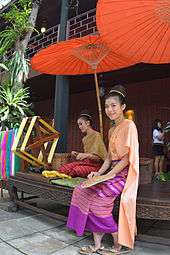Sabai

Sabai or sbai (Khmer: ស្បៃ; Thai: สไบ, RTGS: sabai, pronounced [sābāj]; Lao: ສະໄບ), or phaa biang (Lao: ຜ້າບ່ຽງ; Thai: ผ้าเบี่ยง, pronounced [pʰâː bìa̯ŋ]) is shawl-like garment, or breast cloth worn in mainland Southeast Asia. The term "Sabai" is used for a woman's silk breast wrapper in Cambodia, central Thailand, southern Thailand, northern Thailand, Isan, and Laos while in coastal Sumatra it is described as a shoulder cloth.[1]:410 A Sabai can also be worn by men in Lao weddings or when attending religious ceremonies. The type of Sabai typically worn by Lao men often has checkered patterns. Sabai also well known as a long piece of silk, about a foot wide, draped diagonally over the chest covering one shoulder with one end dropping behind the back."[2]
History

Along with the shoulder sash, selendang of Malay and Sabai of Cambodia and Thailand may have been derived from the Indian garment called a sari, the end of which is worn over one shoulder[1]:153, as most Southeast Asia countries were ruled by Indianized kingdoms.
There are related mythologies in the Khmer culture concerning the history of Sabai, which was likely invented during the Funan era in Cambodia's history, in the 1st century AD. The Sabai is mentioned in Preah Thaong and Neang Neak, a legend with the founders of the Kingdom of Funan as the two main characters. In one scene, Preah Thong clings to a piece of cloth known worn on the Nagini in order to make the journey to the Nāga's kingdom; that piece of cloth is a Sabai. In that tale, Sabai is symbolic of Neang Neak, the Naga princess's tail.[3] For instance, there is an important little rite within the marriage ceremony called Preah Thong Taong Sbai Neang Neak, a symbolic representation of the legend as the groom must to hang on to the bride's Sabai as they go to their room for the honeymoon.[4]
However, according to illustrations in temples since the beginning of Khmer Empire rule, most Apsara seemed to have left the upper body nude, wearing only Khmer traditional sarong kor and their style of Sampot. Sabai may reflect the clothing of Buddhist monks whose robes also have one end hanging over a shoulder. Beginning from Ponhea Yat of the Chatomok era, the court lady is known to have worn the Sabai.[1]:374. The Sabai is Cambodia's national costume together with the ancient sampot and chang kben.
Archaeological evidence from a Mon Dvaravati site depicts five ladies playing instruments and wearing what seems to be a piece of fabric hanging from their shoulder which is quite similar to Sabai.[5] Mon Dvaravati culture practices Theravada Buddhism which later influenced the Tai in the 13th century.
References
- 1 2 3 Robyn J. Maxwell, Mattiebelle Gittinger, Textiles of Southeast Asia: Tradition, Trade and Transformation
- ↑ Bonnie Ghazarbekian, Jane Siegel, Sawaddi, 15 years, p.130.
- ↑ Khmer Traditional Wedding
- ↑ Cambodian history rich with female role-models and rulers
- ↑ http://www.chatnirun.com/wp-content/uploads/2011/09/Poon1.jpg